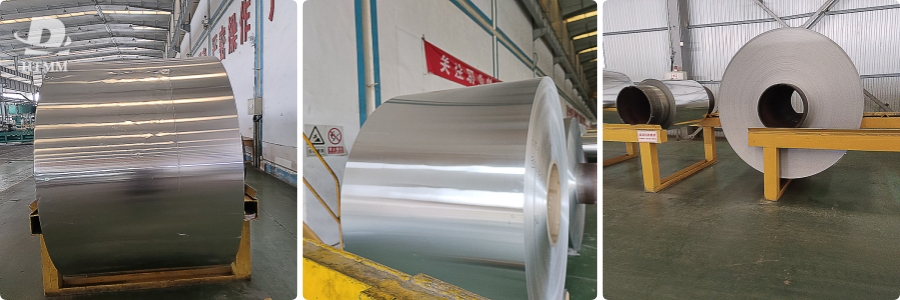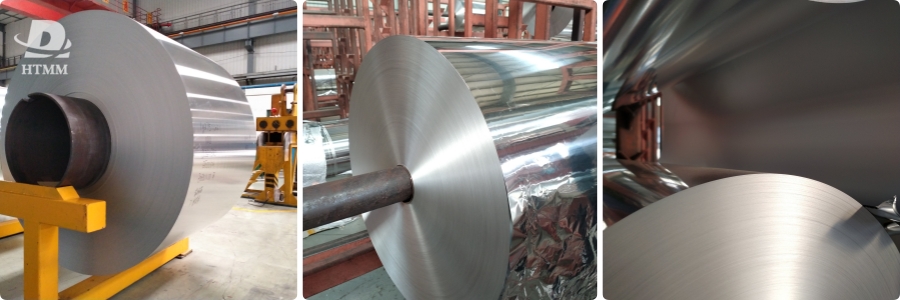In this detailed paper, we present an objective comparison between aluminum foil jumbo roll and popular plastic films. We'll look at material attributes, production procedures, end-use performance, and environmental implications. Real-world case studies illustrate strategic choosing. Our mission is to enable people to make educated decisions that are in line with their own needs and values.

Let's start with the fundamental differences between metal and plastics. From there, we'll look at conversion capabilities, critical performance variables, and sustainability viewpoints to decide the optimal solution for each individual scenario. By the end, you'll be well-prepared to choose packaging components that are properly fitted to your goals.
Material attributes
Fundamentally, aluminum foil jumbo roll and plastics each have intrinsic features that fit specific requirements:
With a weight of about 2.7g per cubic centimeter, aluminum foil jumbo roll raw material for food is strong and lightweight. Plastics are less strong but have more flexibility, with a range of 1-2g/cm3.
Barrier: In terms of resistance to oxygen and moisture transfer, aluminum performs better than other polymers, with the exception of high-barrier kinds.
Strength: Cast plastic films are not as strong as aluminum foil jumbo roll raw material for food produced with typical tempers, and longer shaping is possible due to improved elongation.
Aluminum has a high heat resistance of up to 220°C, while most plastic films would distort below 100°C if plasticizer is not added.
Flexibility: Although plastics are excellent, ultra-thin food grade aluminium foil raw material rivals blown films in several applications due to its strength and flexibility combination.
Toxicity: Pure food grade aluminium foil raw material doesn't provide any safety or legal issues when it comes to food contact, unlike other plastic additive migrations that may be dangerous.
Recyclability: Plastics break down or leak into the environment, yet aluminum can be recycled endlessly to maintain its purity.
Technologically speaking, no single substance can duplicate the very well-balanced physical profile of aluminum foil raw materials for food packaging in every application scenario. Each specializes in a certain field.
Ability to Convert
Accessible processing techniques expand the usefulness of each material beyond its fundamental properties.
Slitting and sheeting, embossing for textures and shapes, printing custom designs, and making 3D objects or containers are examples of aluminum foil raw materials for food packaging manufacturing processes.
Conversion into several layers
Plastic processing lines include blown and cast films.
- For composites, the processes include coextrusion, blow molding, and thermoforming.
- Decorating with coatings or inks
Aluminum foil manufacturers add value through intricate shape, finishing, and multilayer composite structures that plastic film manufacturers are unable to achieve, even if plastics can create films on a vast scale. Capabilities are optimized by complementary integration.
Performance Characteristics:
The advantages of each material are highlighted by the ensuing end-use performance indicators:
Aluminum outperforms all polymers, with the exception of some high-barrier EVOH/PA variants.
Aluminum can endure temperatures as high as 220°C, which makes it far more heat resistant than typical plastic packaging.
Hydrophobic metals are more resistant to oil/fat interactions than hydrophilic polymers.
Product Contamination: Pure aluminum poses no risks to food safety or additive migration.
Abuse Resistance: Strategically gauged metal can withstand point impacts, unlike plastic films.
Reclosability: Metal offers a durable disposable barrier, while some plastic lids reseal.
Durability
Regarding corporate responsibility, there are environmental consequences associated with both materials.
Purchasing Raw Materials: Polymers need a finite amount of oil, but aluminum is supported by an abundance of bauxite.
Manufacturing Emissions: The energy required to produce one ton of aluminum is lower.
Transport Footprint: Compared to larger shipments, aluminum is lighter and requires less freight.
Recyclability: Unlike most polymers, which lose quality over time, aluminum is always pure.
While bio-based and recycled polymers are a possibility, aluminum is not a renewable resource.
Toxicology in Use and Disposal: Pure aluminum is safe to use, in contrast to potential additives in certain polymers.
By combining the technological and sustainability benefits of aluminum foil, plastic sheets, and composite structures in a strategic way, total efficiency is improved.
Methods of Conversion:
Reclosability: Metal offers a durable disposable barrier, while some plastic lids reseal.
Durability
Regarding corporate responsibility, there are environmental consequences associated with both materials.
Purchasing Raw Materials: Polymers need a finite amount of oil, but aluminum is supported by an abundance of bauxite .
Manufacturing Emissions: The energy required to produce one ton of aluminum is lower.
Transport Footprint: Compared to larger shipments, aluminum is lighter and requires less freight.
Recyclability: Unlike most polymers, which lose quality over time, aluminum is always pure.
While bio-based and recycled polymers are a possibility, aluminum is not a renewable resource.
Toxicology in Use and Disposal: Pure aluminum is safe to use, in contrast to potential additives in certain polymers.
By combining the technological and sustainability benefits of aluminum foil, plastic sheets, and composite structures in a strategic way, total efficiency is improved.
Methods of Conversion:
- Components inside complex mold cavities are adorned with in-mold labeling. - Lamination is a process that joins various materials to substrates, including plastic sheets.
Both materials enhance performance for a variety of applications that each might offer alone by directing conversion knowledge. Value is increased throughout the packaging environment through strategic integration.
Actual Cases
Let's examine two case studies where the optimal material choice was determined by taking sustainability issues and technical factors into account.
Major Food Manufacturer Requirements: Deli meat trays with dependable oxygen and moisture barrier, grease resistance, drop strength, stiff construction for stacking, and a high recycled content objective.

The client chose aluminum foil/recycled PETG composite trays laminated in customized lines. Aluminum fulfilled crucial barrier and strength requirements, while recycled PETG provided rigidity and ecological credentials. Adding PETG improved printability and consumer appeal as compared to bare foil.
Global Beverage Brand
Requirements: Stand-up flexible pouches for carbonated beverages requiring heat sealing barrier, chemical resistance to acidic contents, and minimal carbon footprint.
In this instance, the customer selected high-barrier plastic laminate films offering a lighter weight and recycled resin content better suiting their filling lines and sustainability objectives versus rigid structures.
These examples illustrate how to objectively weigh technical, economic and environmental factors determining the packaging solution optimally aligned with strategic priorities – plastic, aluminum foil or integrated composites wherever each material excels.
While plastics transformed consumer packaging availability and economics, aluminum foil maintains compelling advantages depending on need. Strategically leveraging intrinsic material strengths and sophisticated manufacturing techniques together optimizes packaging performance, value and sustainability.
Rather than recommend one material universally superior, our goal is empowering objective comparisons aligning solution criteria precisely with individual requirements and corporate objectives. Both aluminum foil and plastics fill crucial yet distinct roles within responsible packaging portfolios maximizing overall value holistically.

